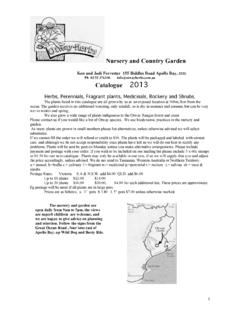Transcription of Echinacea purpurea - Perennials
1 Do cument is Fact Sheet FPS-192, one of a series of the Environmental Horti culture Department, Florida Cooperative Extension Service , Institute of Foodand Agricult ural Science s, Universit y of Florida. Publication date: October, 1999 Please visit the EDIS Web sit e at Institute of Food and Agricultural Sciences is an equal opportunity/affirmative action employer authorized to provide research, educationalinformation and other services only to individuals and institutions that function without regard to race, color, sex, age, handicap, or national information on obtaining other extension publications, contact your county Cooperative Extension Service office. Florida CooperativeExtension Service / Institute of Food and Agricultural Sciences / University of Florida / Christine Taylor Waddill, F.
2 Gilman, professor, Environmental Horticulture Department, Cooperative Extension Service, Institute of Food and Agricultural Sciences, Universityof Florida, Gainesville, 1. Purple Sheet FPS-192 October, 1999 Echinacea purpurea1 Edward F. Gilman2 IntroductionFormerly known as Rudbeckia purpurea PurpleConeflower displays wonderful daisy-like, pink flowers on topof strong, hairy stems that stand against the wind and rain(Fig. 1). Flowers stand 2- to 4-feet-tall, well above themedium-green foliage. The large flowers have a dark purplecenter with a variety of outer-flower colors from pink,lavender to purple. Flowers appear in spring and summer incentral Florida and in the summer elsewhere in the There is nothing quite like a Purple Coneflower inbloom.
3 General InformationScientific name: Echinacea purpureaPronunciation: eck-kin-NAY-see-uh pur-PURE-ee-uhCommon name(s): Purple ConeflowerFamily: CompositaePlant type: herbaceousUSDA hardiness zones: 4 through 10 (Fig. 2)Planting month for zone 7: year roundPlanting month for zone 8: year roundPlanting month for zone 9: year roundPlanting month for zone 10 and 11: year roundOrigin: native to FloridaUses: naturalizing; cut flowers; edging; attracts butterflies;mass plantingAvailablity: somewhat available, may have to go out of theregion to find the plantDescriptionHeight: 1 to 3 feetSpread: 2 to 3 feetPlant habit: oval; uprightPlant density: moderateGrowth rate: moderateTexture: coarseEchinacea purpurea -- Purple Coneflower Page 2 October 1999 Figure 2.
4 Shaded area represents potential planting Leaf arrangement: alternateLeaf type: simpleLeaf margin: serrateLeaf shape: lanceolateLeaf venation: pinnateLeaf type and persistence: deciduousLeaf blade length: 2 to 4 inchesLeaf color: greenFall color: no fall color changeFall characteristic: not showyFlowerFlower color: pink; lavender; purpleFlower characteristic: summer flowering; spring floweringFruitFruit shape: unknownFruit length: unknownFruit cover: unknownFruit color: unknownFruit characteristic: inconspicuous and not showyTrunk and BranchesTrunk/bark/branches: typically multi-trunked or clumpingstemsCurrent year stem/twig color: greenCurrent year stem/twig thickness: mediumCultureLight requirement: plant grows in part shade/part sun; plantgrows in the shadeSoil tolerances: well-drained; occasionally wet; acidic; slightlyalkaline; loam.
5 ClayDrought tolerance: highSoil salt tolerances: poorPlant spacing: 18 to 24 inchesEchinacea purpurea -- Purple Coneflower Page 3 October 1999 OtherRoots: not applicableWinter interest: no special winter interestOutstanding plant: plant has outstanding ornamental featuresand could be planted moreInvasive potential: aggressive, spreading plantPest resistance: long-term health usually not affected by pestsUse and Management The stiff appearance of Purple Coneflower contrasts wellwith the softness of other Perennials and other fine-texturedplants. The plant attracts much attention due to the wonderfulflower and makes a nice component in a mixed perennialborder. It is especially useful in light shade in summer, whereprotection from afternoon sun enhances flower and foliagecolor.
6 It is fairly tolerant of drought in the partial shade, less soin full sun. Clumps of Purple Coneflower should be divided every fewyears to help keep plants blooming. Growers also propagate byroot cuttings. Coneflowers with white flowers also exist. Roots have been used to treat rabbies, snakebites, skindiseases and other ailments. Pests and Diseases Purple Coneflower can be moderately to severely infestedwith Sweetpotato whitefly. Japanese beetle in northern gardens eat foliage anddisfigure plants. Leaf spots can be a problem any place theplant is grown.





